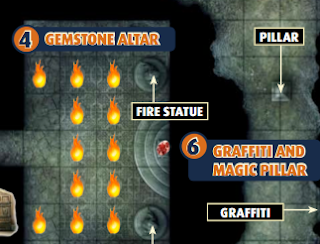I’ve been thinking a lot lately about procedural ways to generate campaign elements. In my mind, this is significantly different than randomly generating things using some framework, which is often how computer tools work. There can also be randomness in the kind of system I am talking about, but each decision point need not be decided randomly or from some set of limited options. The ACKS guidelines for creating a campaign are kind of like this, but are perhaps a bit more free-form.
That is, the rules for such a system must be clear enough to guide you at every step, though they don’t need to be algorithmic. These are, it seems to me, the same requirements for a good game, and in fact there are a number of standalone games that can be used like this. Microscope was probably the first of these kind of games that I have started to investigate recently. It is a collaborative game that designs a setting. I really like the idea of using Microscope to build a D&D campaign setting, as the resulting setting would grow from the entire group rather than just the referee. It seems like a very natural way to navigate the problems of expectation regarding genre and tone. See also the discussion of Microscope on Monsters & Manuals here and here.
How to Host a Dungeon is a game that develops a dungeon by proceeding through historical eras. There are some standard assumptions about fantasy races built in, but it should be easy to hack for other styles of setting if so desired. It is available in PDF for $5.
FrDave over at Blood of Prokopius also had a recent post about using the railroad board game Empire Builder to generate underworld settings like the one presented in D1-2 Descent into the Depths of the Earth. There are also themed versions of Empire Builder, including Martial Rails, Lunar Rails, and Iron Dragons (about “fantasy” railroads). My guess is that the original is probably fine for this purpose, as some post-processing will be needed in any case to adapt the results for use with a tabletop RPG.
I asked a question on G+ about other such games, and someone mentioned Dawn of Worlds, which is freely available in PDF. It looks somewhat similar to Microscope, but it starts with the premise that every player is a god that has a certain level on influence on the resulting world.
Several people suggested the computer game Dwarf Fortress, a text-only computer game that simulates a dwarven colony. I have never played Dwarf Fortress, but there is an interesting article about it in the New York Times. I don’t have time to look into this game now, but I know it has a very devoted following and might be worth returning to at some point. I’m not sure how easy it would be to import the game result directly into a tabletop RPG, but it could still provide inspiration (and maybe maps).
I would be curious to hear if anyone knows of other games that can be used in this way, or if anyone has experiences building setting elements using games like this.





